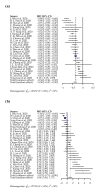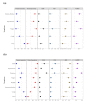Diagnostic accuracy of clinical signs and symptoms of COVID-19: A systematic review and meta-analysis to investigate the different estimates in a different stage of the pandemic outbreak
- PMID: 37441773
- PMCID: PMC10344460
- DOI: 10.7189/jogh.13.06026
Diagnostic accuracy of clinical signs and symptoms of COVID-19: A systematic review and meta-analysis to investigate the different estimates in a different stage of the pandemic outbreak
Abstract
Background: The coronavirus (COVID-19) pandemic caused enormous adverse socioeconomic impacts worldwide. Evidence suggests that the diagnostic accuracy of clinical features of COVID-19 may vary among different populations.
Methods: We conducted a systematic review and meta-analysis of studies from PubMed, Embase, Cochrane Library, Google Scholar, and the WHO Global Health Library for studies evaluating the accuracy of clinical features to predict and prognosticate COVID-19. We used the National Institutes of Health Quality Assessment Tool to evaluate the risk of bias, and the random-effects approach to obtain pooled prevalence, sensitivity, specificity, and likelihood ratios.
Results: Among the 189 included studies (53 659 patients), fever, cough, diarrhoea, dyspnoea, and fatigue were the most reported predictors. In the later stage of the pandemic, the sensitivity in predicting COVID-19 of fever and cough decreased, while the sensitivity of other symptoms, including sputum production, sore throat, myalgia, fatigue, dyspnoea, headache, and diarrhoea, increased. A combination of fever, cough, fatigue, hypertension, and diabetes mellitus increases the odds of having a COVID-19 diagnosis in patients with a positive test (positive likelihood ratio (PLR) = 3.06)) and decreases the odds in those with a negative test (negative likelihood ratio (NLR) = 0.59)). A combination of fever, cough, sputum production, myalgia, fatigue, and dyspnea had a PLR = 10.44 and an NLR = 0.16 in predicting severe COVID-19. Further updating the umbrella review (1092 studies, including 3 342 969 patients) revealed the different prevalence of symptoms in different stages of the pandemic.
Conclusions: Understanding the possible different distributions of predictors is essential for screening for potential COVID-19 infection and severe outcomes. Understanding that the prevalence of symptoms may change with time is important to developing a prediction model.
Copyright © 2023 by the Journal of Global Health. All rights reserved.
Conflict of interest statement
Disclosure of interest: The authors completed the ICMJE Disclosure of Interest Form (available upon request from the corresponding author) and disclose no relevant interests.
Figures





Similar articles
-
Signs and symptoms to determine if a patient presenting in primary care or hospital outpatient settings has COVID-19.Cochrane Database Syst Rev. 2021 Feb 23;2(2):CD013665. doi: 10.1002/14651858.CD013665.pub2. Cochrane Database Syst Rev. 2021. Update in: Cochrane Database Syst Rev. 2022 May 20;5:CD013665. doi: 10.1002/14651858.CD013665.pub3. PMID: 33620086 Free PMC article. Updated.
-
Diagnostic accuracy of symptoms as a diagnostic tool for SARS-CoV 2 infection: a cross-sectional study in a cohort of 2,173 patients.BMC Infect Dis. 2021 Mar 11;21(1):255. doi: 10.1186/s12879-021-05930-1. BMC Infect Dis. 2021. PMID: 33706707 Free PMC article.
-
Correlations of Clinical and Laboratory Characteristics of COVID-19: A Systematic Review and Meta-Analysis.Int J Environ Res Public Health. 2020 Jul 13;17(14):5026. doi: 10.3390/ijerph17145026. Int J Environ Res Public Health. 2020. PMID: 32668763 Free PMC article.
-
Coronavirus disease (COVID-19) pandemic: an overview of systematic reviews.BMC Infect Dis. 2021 Jun 4;21(1):525. doi: 10.1186/s12879-021-06214-4. BMC Infect Dis. 2021. PMID: 34088271 Free PMC article. Review.
-
Clinical Features of COVID-19 Patients in the First Year of Pandemic: A Systematic Review and Meta-Analysis.Biol Res Nurs. 2022 Apr;24(2):172-185. doi: 10.1177/10998004211055866. Epub 2021 Dec 4. Biol Res Nurs. 2022. PMID: 34866409 Free PMC article.
Cited by
-
Temporal, spatial and demographic distributions characteristics of COVID-19 symptom clusters from chinese medicine perspective: a systematic cross-sectional study in China from 2019 to 2023.Chin Med. 2024 Dec 18;19(1):171. doi: 10.1186/s13020-024-01043-4. Chin Med. 2024. PMID: 39695848 Free PMC article.
-
A six-year study in a real-world population reveals an increased incidence of dyslipidemia during COVID-19.J Clin Invest. 2024 Sep 12;134(21):e183777. doi: 10.1172/JCI183777. J Clin Invest. 2024. PMID: 39264723 Free PMC article.
-
The burden of COVID-19 death for different cancer types: a large population-based study.J Glob Health. 2025 Feb 14;15:04046. doi: 10.7189/jogh.15.04046. J Glob Health. 2025. PMID: 39946554 Free PMC article.
-
Risk factors for SARS-CoV-2 pneumonia among renal transplant recipients in Omicron pandemic-a prospective cohort study.Virol J. 2024 Dec 4;21(1):315. doi: 10.1186/s12985-024-02591-9. Virol J. 2024. PMID: 39633492 Free PMC article.
-
Post COVID-19 and Long COVID Symptoms in Otorhinolaryngology-A Narrative Review.J Clin Med. 2025 Jan 14;14(2):506. doi: 10.3390/jcm14020506. J Clin Med. 2025. PMID: 39860512 Free PMC article. Review.
References
Publication types
MeSH terms
Grants and funding
LinkOut - more resources
Full Text Sources
Medical
